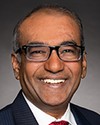Thank you, Madam Chair.
Thank you, Madam Ambassador, for spending a few minutes with us today.
You talked about the three pillars that work at the WTO. They are the deliberative pillar, the negotiating pillar and the dispute settlement pillar.
Instead of your three pillars, I want to take you back to the three pillars proposed by the Deputy Prime Minister in her speech a couple of weeks ago in Washington. I'm sure you must have heard it or read about it.
In my opinion, our Deputy Prime Minister said that globalization and the global trade system as we know them are almost done. She was specifically referring to the rules-based system of global free trade as we have practised it over the last several decades. It was quite successful, as far as trading went. However, the fundamentals changed during the pandemic and in what is currently happening in the world today.
The three pillars she mentioned are as follows, and I'm paraphrasing here. First, she said that the western liberal democracies—western Europe, North America, Australia, Japan and Korea—should have their own economic co-operation.
Then the second pillar she suggested—which I think she also acknowledged is the hardest—is what we do with the countries in the middle. These are the countries in Asia, Africa and Latin America that are not as liberal a democracy as we are and that do not follow the global orders-based system as we do. What do we do with them when it comes to, say, “friend-shoring”, the term that was used by U.S. Secretary Janet Yellen?
The third pillar our Deputy Prime Minister mentioned was that we have to deal with adversaries like China and Russia, although she did not name them directly. We have to work with them to tackle climate change and to deal with arms security. She said that we should go back to the way we used to deal with things during the Cold War, when we learned to contain them and engage with them at the same time.
These are the three pillars.
To start, I would like your opinion on her entire speech.

